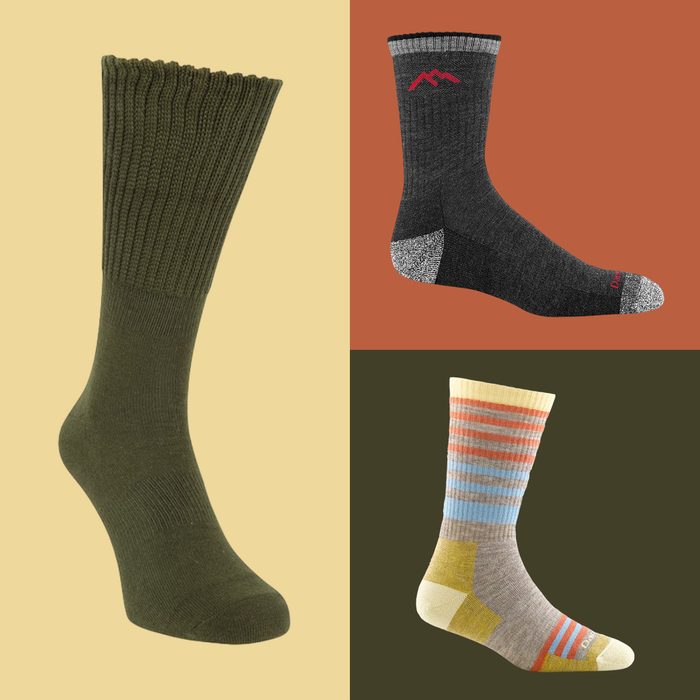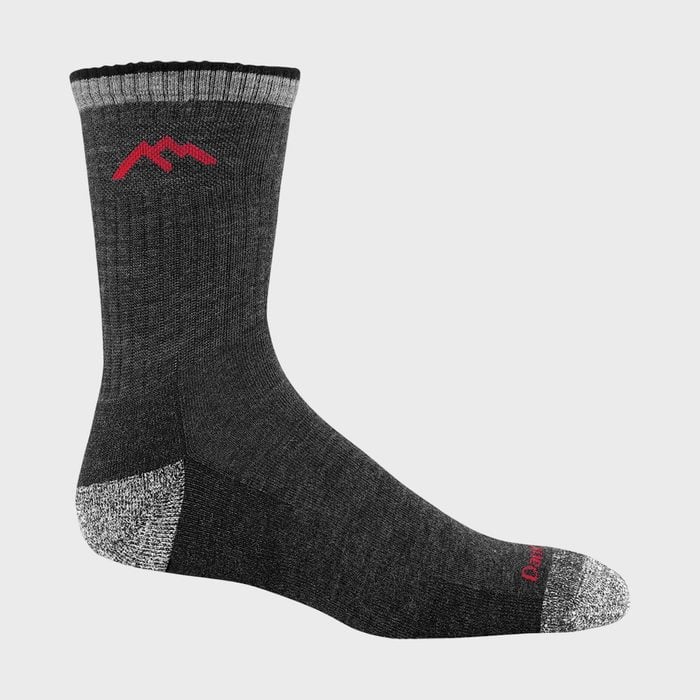
Best overall
Darn Tough Merino Wool Hiker Micro Crew
These Darn Tough socks have become my favorite hiking and walking sock, thanks to their temperature regulation, softness and micro-crew height that hits above the ankle. The socks contain a small amount of spandex for stretch and nylon for durability, but their real secret weapon is the Merino wool. This do-it-all fabric boasts supreme temperature regulation properties; it’s able to keep you warm in the winter and cool during the summer.
Yes, merino wool works both ways—how else would merino sheep survive the harsh temperature swings of the mountainous regions in which they reside? Plus, merino wool is much finer and softer than most other forms of wool, which makes for luxuriously comfortable hiking socks. These ones come in earthy colors and outdoorsy designs to go with your hiking boots.
Pros
- Merino wool construction
- Extremely soft
- Micro crew height prevents rub from boots without being too high
- Elite temperature regulation in all seasons
- Wicks sweat
Cons
- Expensive
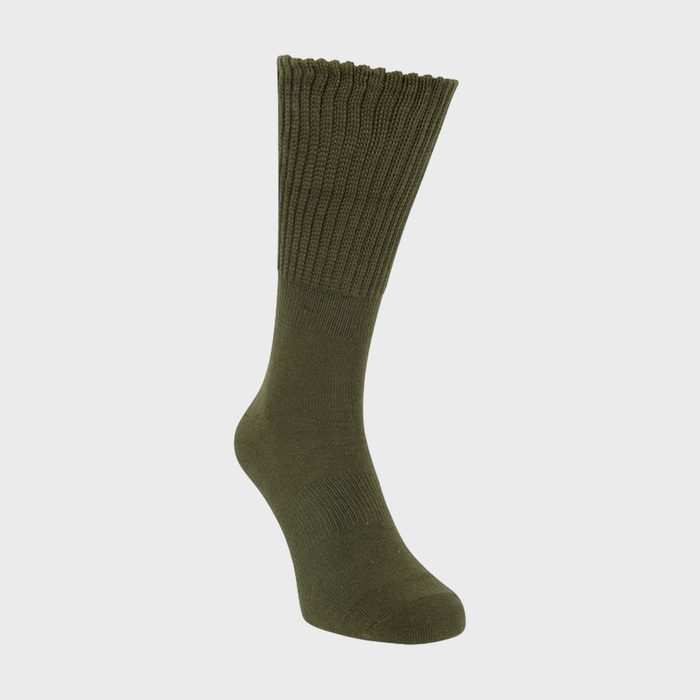
Best budget
Mountain Warehouse Anti-Chafe Hiking Socks
For day hikes and overnighters alike, these Anti-Chafe Hiking Socks perform well without putting a huge dent in your wallet. These cost almost $10 less per pair than our top pick for the best hiking socks, and they’re often on sale for at least 30% off. The lower price means you aren’t getting top-tier fabrics like merino wool, but these socks still wick away moisture and resist odors from bacteria, thanks to the synthetic material that’s treated to be antimicrobial.
Additionally, the anti-chafe lining and fine-toe seams help reduce the risk of blisters. These socks feature a “bunch up” cuff design—it lacks compression and it won’t be for everyone, but I think it looks cute to slouch down the extra length to the rim of your hiking boots.
Pros
- Easy on the wallet compared to other top options
- Antimicrobial-treated fabric wicks sweat and resists odors
- Anti-chafe lining reduces risk of blisters
- Crew height prevents rubbing from shoes or boots
Cons
- The “bunch up” style isn’t for everyone
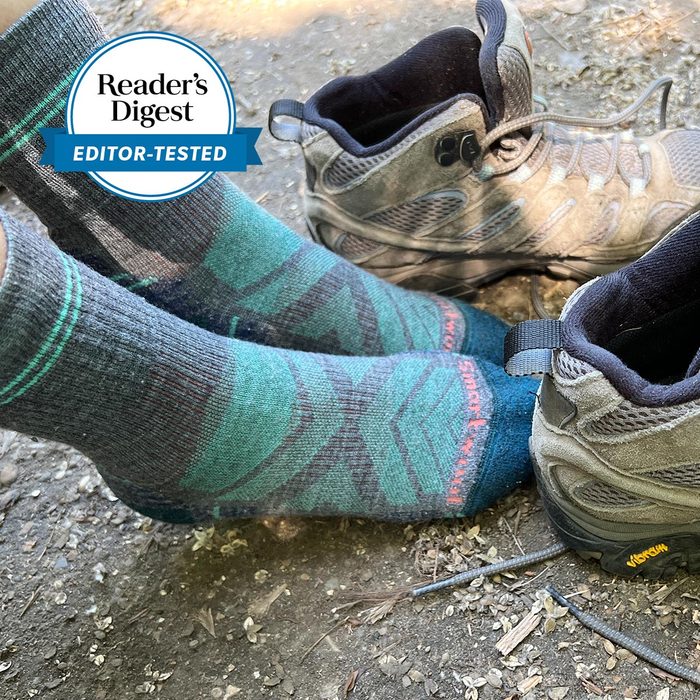
Best wool
Smartwool Performance Hike Light Cushion Mid Crew Sock
Like Darn Tough’s, Smartwool socks have catapulted to popularity among outdoor enthusiasts including myself for their use of versatile Merino wool. I own a couple pairs of these socks and when it’s time for a jaunt in the woods—whether I’m going for an easy walk or a trail run—it’s always a draw between my Darn Tough socks and my Smartwool socks. And don’t just take my word for it—they’re the go-to pair for Reader’s Digest senior shopping editor Megan Mowery.
“I’ve long been a fan of Smartwool socks,” Mowery says. “I live in Minnesota, which means frigid winters and hot-and-humid summers. My Smartwools stand up to all weather, even keeping my feet moisture-free when on strenuous summer hikes. I love them so much, I’ve amassed a collection of about a dozen pairs—and in the past 10 years, I’ve only had to retire one pair. They’re the only performance socks I’ll ever buy, for wear on the trails and off.”
These ones feature light cushions along the underfoot. They’re also lightly compressive, which I really love as it reduces bunching. The mid-crew height peeks out above my hiking boots and that plus the fine seaming prevents blisters.
Pros
- Merino wool fabric regulates temperature
- Lightly compressive fit
- Underfoot cushioning
- Moisture-wicking
Cons
- Over $20 a pair
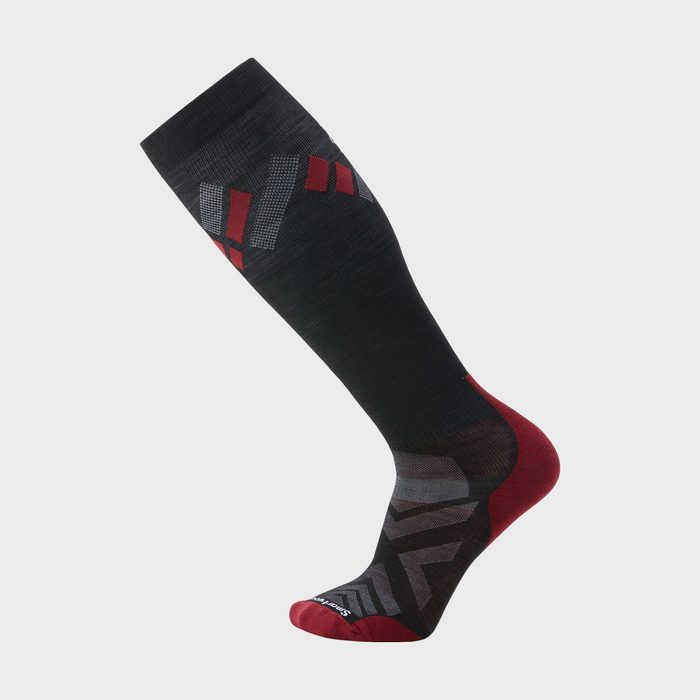
Best compression
Smartwool Athlete Edition Mountaineer OTC Socks
Another Smartwool pick, the Athlete Edition Mountaineer OTC Socks have been a lifesaver for me during long day hikes and backpacking trips. These feature a graduated compression rating of 20 mmHg to 30 mmHg, with the most compression hitting around the mid-calf. I typically reserve these for my longer hikes, but they’re great for any type of trail day.
Like all Smartwool socks, these are made primarily of merino wool for temperature regulation and moisture wicking, but they also contain 12% nylon, 34% recycled nylon and 4% elastane for durability and stretch. Compression socks are designed to reduce or prevent swelling that occurs due to fluid retention when you’re on your feet for long periods of time. They’re also amazing for long air travel and days that require a lot of sitting at a desk since fluid can build up in the lower leg in those scenarios too.
Pros
- 20 to 30 mmHg graduated compression
- 50% merino wool construction
- Nylon and elastane provide structure, stretch and compression
- Great for long trail days, mountaineering and backpacking
Cons
- Over $30 a pair
- Not many colors to choose from
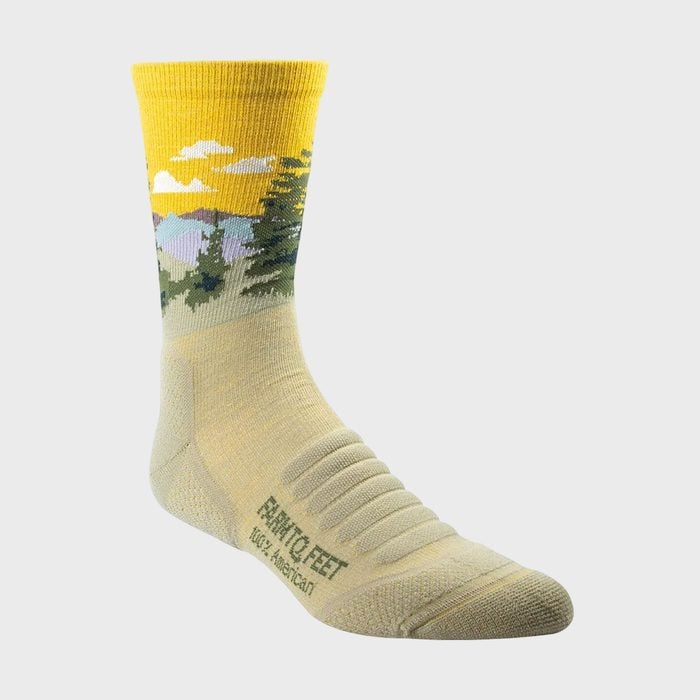
Best for summer
Farm to Feet Cascade Locks Lightweight Crew Hiking Socks
These Farm to Feet socks are by far some of the best summer hiking socks—light and breathable with just enough cushion underfoot to provide comfort but not keep too much warmth in. The 42% merino wool, 54% nylon and 4% Lycra material make for a great blend of breathability, softness, stretch and compression.
They also feature a seamless toe line to reduce bunching and blisters. The light cushioning on the upper midfoot of the sock sits right on top of the foot bone which can sometimes suffer from the pressure of a hiking boot. The three-quarter crew height means they rise just above the rim of most hiking boots so your ankles and heels stay protected from any potential rubbing.
Pros
- Lightweight and breathable for hot temperatures
- Merino wool for temperature regulation
- Lycra and nylon for stretch and durability
- Underfoot and upper cushioning
- Seamless toe line
Cons
- Only available S and XL sizing
- Over $20 a pair
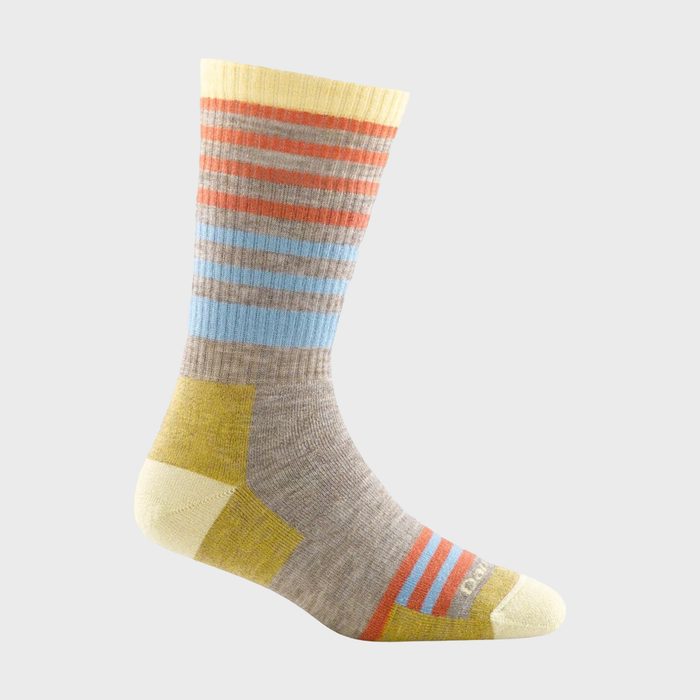
Best cushioned
Darn Tough Gatewood Boot Full Cushion Sock
Whatever your reason for needing extra cushion in your socks, be it for warmth or pain relief, the Darn Tough Gatewood socks get the job done. They feature full cushioning throughout the entire sock, including the underfoot, heel and upper, with “True Seamless” construction to reduce the likelihood of blisters.
Made of 67% merino wool, these socks wick sweat away from your skin despite the extra cushioning, but because they’re on the thicker side, they will wear hotter than others on this list. The rest of the fabric consists of 30% nylon for durability and abrasion resistance—no holes at the toes!—and 3% Lycra for stretch and light compression.
Pros
- Full cushioning throughout the entire sock
- Seamless construction
- Lycra included for stretch
- 30% nylon construction makes them resistant to tearing
Cons
- Almost $30 per pair
- Possibly too warm for very hot climates
What to consider when buying the best hiking socks
As you continue your search for the best socks for hiking, make a note of these factors to decide which pair is the best suited to your needs and preferences.
-
Fabric type: Look for fabrics like merino wool or other wool, nylon, elastane and Spandex. The former two are included for temperature regulation, padding and moisture wicking, while the latter three provide durability and stretch.
-
Height: Where does the sock line fall—beneath, at or above the ankle? Mid-calf? Below the knee? In my experience, socks that hit from just above the ankle to below the mid-calf are the best for hiking because they help prevent blisters and often offer some compression, but everyone has different preferences for fit.
-
Compression: Do the socks offer a little compression, a lot or none? For long hikes, you’ll typically want at least a little bit of compression around the midfoot for long-lasting comfort. For more arduous hikes, full-length compression socks with gradient compression can help a lot with the inevitable fluid retention that occurs from being on your feet all day.
-
Thickness: Thickness is an important attribute of hiking socks because it can deeply affect your comfort and performance during a hike. Socks that are too thick or too thin for your boots may permit chafing and/or blisters, as well as problems with temperature regulation.
-
Weather: Weather will impact the type of hiking socks you need in terms of warmth. Typically, you’ll want lighter-weight socks for summer and thicker ones for winter. In terms of materials, synthetics aren’t as good at holding in warmth as wool, which is ideal for temperature regulation.
How we found the best hiking socks
As shopping experts, our only job is to help you find a winning product. We start with the research and reporting basics—what products are made of, what they look like and how much they cost—to ensure that we’re only recommending the buys that are worth your time and money. Then we research the features that speak to the product’s quality, taking advice from industry insiders and subject matter experts on what makes a product a smart value (or worthy of a splurge). Finally, we do the work of combing through user reviews to see how real people interact with the product, and if it stands up to the test.
FAQ
What socks are best for hiking?
The best hiking socks share similar qualities, such as being made of high-quality, durable, abrasion-resistant materials and offering an element of compression and/or cushion. They should be great at regulating temperature and wicking away moisture to keep feet feeling dry and comfortable.
Are expensive hiking socks worth it?
Usually, I’m a budget-conscious shopper and work hard to find the best bang for my buck. However, when it comes to any garment that I’m wearing while moving for long periods of time—especially in any type of uncomfortable weather—I don’t hold back. That means expensive hiking socks are worth it: What you pay for the socks will ultimately save you money on first aid items like blister pads, Band-Aids and ointment.
Are thick socks better for hiking?
The ideal thickness for hiking socks really depends on personal preference, as well as the fit of your hiking boots and the weather. Thicker socks are often the best hiking socks to prevent blisters. They fill up space in boots that fit loosely, offer more underfoot padding and provide warmth during cold or damp hikes.
Thinner socks work well during summer and in tighter-fitting footwear, under thick socks as a liner for additional warmth, or as a protective layer beneath hiking sandals if that’s more your vibe.

